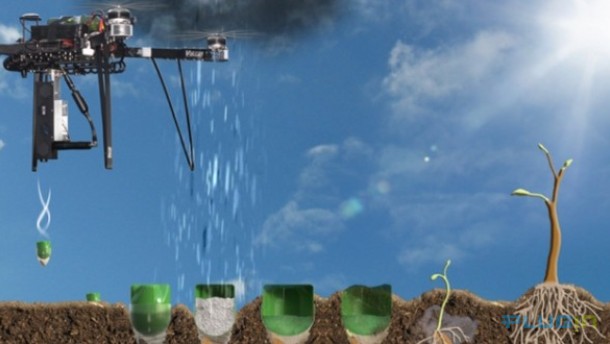Drones Could Plant 1 Billion Trees a Year
Drones are taking on deforestation and planting trees more efficiently than ever before.
Currently, more than 6.5 billion trees are lost each year because of human activities--burning land to make way for livestock, harvesting wood, etc.--and natural disasters.
Replanting efforts have accelerated in recent years and deforestation has slowed, but there's still a major gap between trees destroyed and trees planted. Throughout history, humanity has created a major tree deficit that will be hard to close.
In all, it's estimated that the global tree population has dropped 46% since the dawn of human civilization.
Typically, replanting is done by hand because trees require careful preparation to grow properly.
Human labor, of course, has limits and so replanting efforts tend to be modest.
A former NASA scientist realized that the current model would never close the deforestation deficit, so he devised a strategy to accelerate the process, and it depends on the humanitarian technology of the moment: drones.
Drones have been used for all sorts of progressive delivery projects in the past, but these have mostly consisted of getting products to consumers or medicine to doctors.
BioCarbon Engineering's drones extend this generosity to the environment. The drones work by first flying over an empty field and examining the terrain's conditions.
If the land can foster trees, the drones descened to two to three feet above the ground and begin firing small pods that contain germinated seeds into the soil. The pods protect the seeds until they can establish themselves in the soil and then they degrade.
With 2 drone operators manning multiple drones, the team will be able to plant 36,000 trees a day. In a year, 1 billion trees is the target.
Over time, if more drones are deployed, BioCarbon's efforts can help to restore tree levels to their historic levels.
The team is working with the UN to help restore 300 billion trees by 2030.
The damage wrought by deforestation can't be overstated. Trees allow all life on Earth to occur. They provide oxygen for us all, absorb harmful gases such as carbon and methane, provide habitats for animals and promote general biodiversity. Trees provide food, conserve water, offer protection, cool areas, control water and wind erosion and they filter and perfume the air.
And trees act as a bulwark against climate change. The less trees, the more vulnerable Earth becomes.
Any effort to plant trees--if it's just in your backyard--makes a difference. But to truly have an impact, the scale of change has to enter the millions and the billions.
A part of being a NASA scientist is dreaming big. Most of the time this dreaming is directed beyond the Earth, so it's good to see that powerful imaginative ability being used to help this planet out as well.
by Joe McCarthy
What do you think? Good idea? Or is conservation the best answer? Use less, maintain old growth?
Currently, more than 6.5 billion trees are lost each year because of human activities--burning land to make way for livestock, harvesting wood, etc.--and natural disasters.
Replanting efforts have accelerated in recent years and deforestation has slowed, but there's still a major gap between trees destroyed and trees planted. Throughout history, humanity has created a major tree deficit that will be hard to close.
In all, it's estimated that the global tree population has dropped 46% since the dawn of human civilization.
Typically, replanting is done by hand because trees require careful preparation to grow properly.
Human labor, of course, has limits and so replanting efforts tend to be modest.
A former NASA scientist realized that the current model would never close the deforestation deficit, so he devised a strategy to accelerate the process, and it depends on the humanitarian technology of the moment: drones.
Drones have been used for all sorts of progressive delivery projects in the past, but these have mostly consisted of getting products to consumers or medicine to doctors.
BioCarbon Engineering's drones extend this generosity to the environment. The drones work by first flying over an empty field and examining the terrain's conditions.
If the land can foster trees, the drones descened to two to three feet above the ground and begin firing small pods that contain germinated seeds into the soil. The pods protect the seeds until they can establish themselves in the soil and then they degrade.
With 2 drone operators manning multiple drones, the team will be able to plant 36,000 trees a day. In a year, 1 billion trees is the target.
Over time, if more drones are deployed, BioCarbon's efforts can help to restore tree levels to their historic levels.
The team is working with the UN to help restore 300 billion trees by 2030.
The damage wrought by deforestation can't be overstated. Trees allow all life on Earth to occur. They provide oxygen for us all, absorb harmful gases such as carbon and methane, provide habitats for animals and promote general biodiversity. Trees provide food, conserve water, offer protection, cool areas, control water and wind erosion and they filter and perfume the air.
And trees act as a bulwark against climate change. The less trees, the more vulnerable Earth becomes.
Any effort to plant trees--if it's just in your backyard--makes a difference. But to truly have an impact, the scale of change has to enter the millions and the billions.
A part of being a NASA scientist is dreaming big. Most of the time this dreaming is directed beyond the Earth, so it's good to see that powerful imaginative ability being used to help this planet out as well.
by Joe McCarthy
What do you think? Good idea? Or is conservation the best answer? Use less, maintain old growth?



.jpg)

Comments
Post a Comment